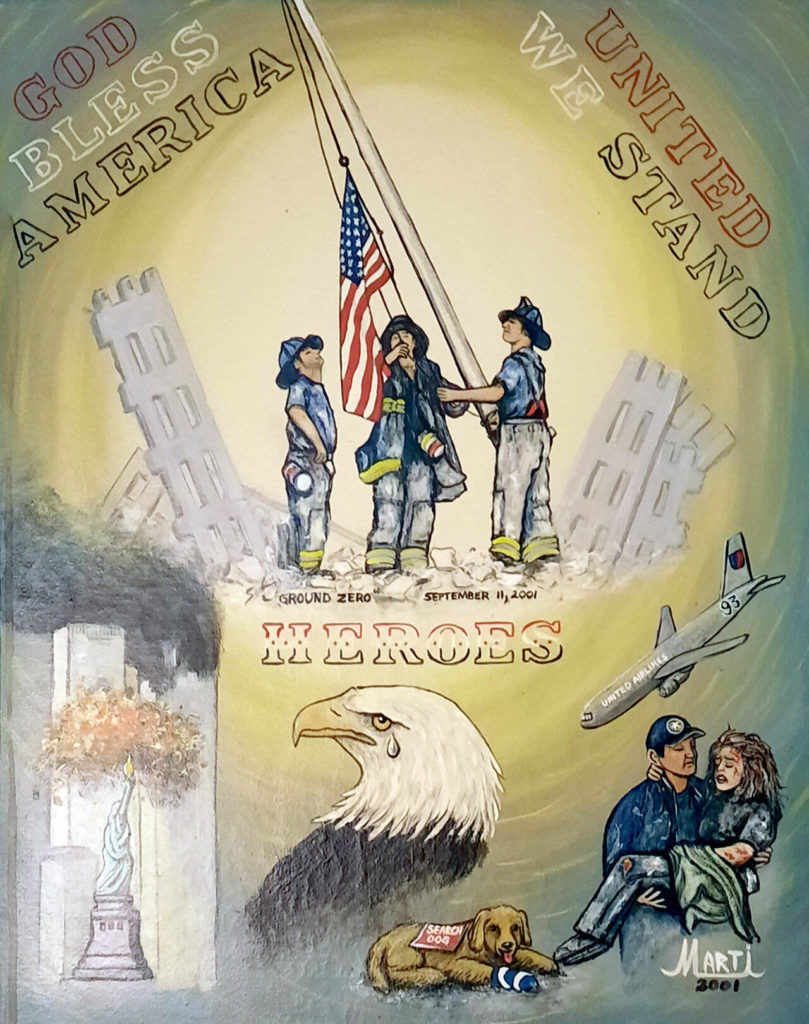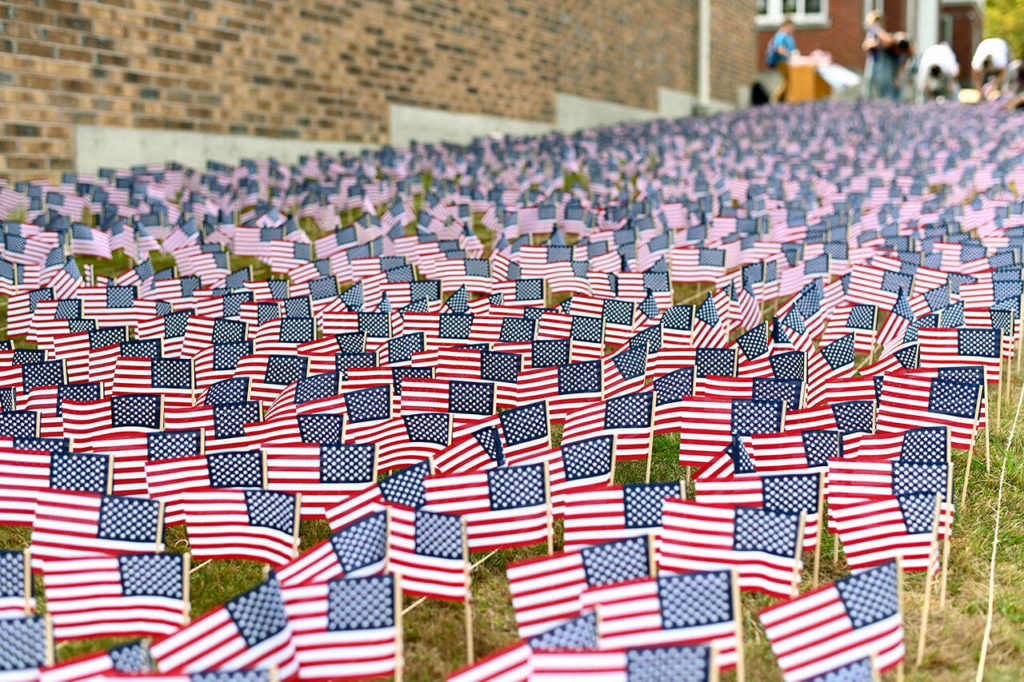Twenty years later, Snohomish County residents will be reflecting on the Sept. 11 terrorist attacks on America in different ways Saturday.
One will think of a friend who was a first responder lost that day. Another will find solace in a painting.
Part of MacLeod Avenue in Arlington will be closed for several hours Saturday as a steel beam from the World Trade Center is displayed at Fire Station 46. City leaders will gather at 7 p.m. to pay their respects.
The Academy of Snohomish paid tribute Thursday, putting out 2,977 small flags on the campus, one for each victim of the attacks. They will remain there through Saturday.
“9/11 happened three years before I was born,” said Blake Habersetzer, chair of the student-run Young Americans for Freedom chapter on the campus at 330 Union Ave. in Snohomish. “No number on a page can relay the gravity of the events, but I think this memorial does. It truly puts into perspective the devastation experienced by our country.”
Stuck abroad
Paul Heise was in the World Trade Center the month before the attacks. But on 9/11, he was in Australia on his first out-of-country business trip. He was set to fly home that day.
What followed were several days the Mill Creek resident will never forget.
Heise was on his way to the airport when his colleague got a call asking if they had seen the news. They hadn’t. They were stunned.
They went back to Melbourne, where Heise tried to call his family, but the call wouldn’t go through. He eventually was able to send emails to let them know he was OK. But he was stuck in Australia for the next four or five days as flights to the U.S. were grounded.
One day, Heise, who said he isn’t religious, went to a church in Melbourne. When someone there realized he was American, they invited him in. He sat in the church in complete silence for an hour reflecting on those uncertain few days.
The part that affects him the most is a seemingly small moment.
Heise had just landed in Los Angeles from Australia after a flight during which it seemed everyone was wracked with anxiety.
He remembers getting off the plane and seeing a police officer. He asked the officer if everything was OK.
“It will be,” the officer said.
“He looked at me and he said, ‘Welcome home,’” Heise said, his voice cracking.
When he finally got back to Seattle, his wife and parents were waiting for him at the airport. His mother hugged him and wouldn’t let go.
‘It can’t happen’
Keith Capellaro was at work in New York state when he heard the news on the radio. He thought it could be a practical joke. But when he changed to another station, they told the same story: A plane had struck the World Trade Center.
Like everyone else, the Stanwood resident was shocked.
“No, it can’t happen, it couldn’t happen,” he said.
His next thought was for his friend, Christopher Blackwell, a New York firefighter. Blackwell died that day. Capellaro used to deliver ice cream to his wife.
He went to his funeral and half a dozen others for firefighters who died in the following months.
Capellaro was a volunteer firefighter for 30 years. One of the memories that sticks with him is what happened after the attacks.
“After we get back from a call, we were driving around and people were cheering and clapping and waving to us while we were driving around,” Capellaro said. “That made my day.”
He said that happened for months.
But every time Capellaro would watch footage from that day in the years after, he’d be a wreck, he said. On 9/11 this year, he’ll try to distract himself with baseball. He’ll be rooting for the New York Yankees against the cross-town rival Mets.
A time capsule
Glenna Atkins used her high school graduation money to buy a cedar chest. Within, she keeps the items she wants to return to, like her diploma and baby shoes. It’s her personal time capsule.
It includes lots of mementos from around Sept. 11. There’s a letter from her boss about coping with the attacks. There are 20-year-old newspapers and magazines. There’s a CD an Everett sailor recorded to aid the 9/11 relief efforts.
Twenty years later, she can now reflect on what she was feeling at the time.
She read Friday from a letter she wrote for the Our Community Reflects event at Everett Mall in the months after.
“At work, I spend the day with all my attention listening to the radio, quietly doing my job without thinking much about what I’m doing,” Atkins wrote in the letter after the attacks. “On the way home, the commute is now changed. Flags flying at half-mast and billboards with words saying, ‘Remember the victims, pray for the families.’”
Atkins has the letter framed in her home.
The Everett Mall space had everything from letters to religious medals to posters of the New York skyline. Atkins said it was emotional to see it all.
“Even though none of us knew them, but we could still come together and have the same feelings for someone that we didn’t know,” she said.
The art of remembering
About once a year around this time, Karen Leslie slips the canvas painting from its cardboard covering. The Everett woman with American flags in her yard studies the montage of images — the eagle with a tear streaming past its beak, the firefighters and rescue workers, the dark billowing smoke and United Airlines Flight 93 still in the sky.
The painting whisks her back in time and becomes an inroad for reflection.
She remembers being 19 in 1977 and off for a big adventure from Snohomish County to New York to visit her husband, Dan, who’d been a student at Pace University in Lower Manhattan. One evening that July she found herself on the top floor of one of the two World Trade Center towers taking in the view of other skyscrapers and boroughs within the 300-square-mile city. A pianist played in the background. And then the city that never sleeps went dark. A massive blackout led to widespread looting and riots. Leslie and others were told they could not leave.
On that night, the towers were her safe haven.
Twenty years ago Saturday morning, Leslie was still in her pajamas in a shack outside of Tonasket, a small town east of the Cascades in the north central part of Washington. She was there to help family members who’d been dealing with health issues. Leslie’s mom limped outside to call her into the family home to join her in front of the TV. The top of one of the twin towers, where Leslie had been those many years before, had collapsed after a jet flew into it.
Leslie told her mom: “Wow, I am glad it didn’t hit the other one.”
“Then boom,” she said. “We were just petrified.”
Like millions of other Americans, Leslie somberly watched the news for days and weeks, heartened by the outpouring of goodwill and sense of national unity.
Leslie bought the painting after striking up a conversation with an artist at a bar in Idaho. It didn’t cost much, but it spoke to her.
In the background is a large, somewhat amorphous patch of yellow.
While many concrete images in the painting tell her to never to forget what happened Sept. 11, 2001, the abstract yellow reminds her she must hold out hope. It somehow makes her feel warm and comforted.
“The sun will shine again,” she said.
Jake Goldstein-Street: 425-339-3439; jake.goldstein-street@heraldnet.com. Twitter: @GoldsteinStreet.
Talk to us
> Give us your news tips.
> Send us a letter to the editor.
> More Herald contact information.



























